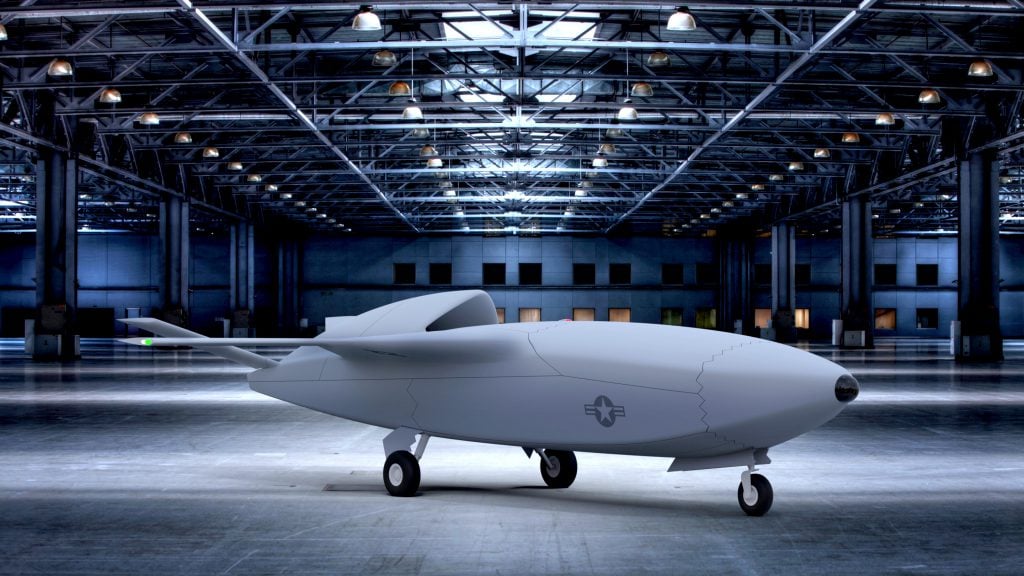
Skyborg, AFRL artist’s image
Is the Air Force about to make the same mistakes with Skyborg that it made with the F-22 and F-35? Sure, they created the most capable aircraft in the world, but they neglected to give them the capacity to share their assessment of the air battlespace situation with our other fighters—and sharing data is the crux of joint operations.
While the Air Force is moving full speed ahead on Skyborg, we don’t know if it’s working with the Joint Artificial Intelligence Center (JAIC) to ensure data sharing — interoperability — in the program. And that goes for the Navy and its efforts to develop its own autonomous platforms.
This is especially troubling since unmanned systems will be a major part of the Defense Department’s future force structure, and Skyborg, the Air Force’s autonomous combat drone program, is on the leading edge of that effort.
Last month, the Air Force announced a big step forward, awarding four companies contracts to develop prototypes. At this pace, the program will be on track to deliver one or more unmanned combat aircraft for flight evaluation by 2023.
Technologies developed within the Skyborg program will inform a range of future Defense Department of Defense investments as the Pentagon prepares to dominate contested environments such as airspace within the umbrella of Chinese and Russian surface-to-air missile systems (SAMS). Success will require all the services to evolve joint concepts of war-fighting that team manned platforms with autonomous weapons systems.
Skyborg is expected to blaze the trail for this sort of manned/unmanned teaming effort, so it is important the program embrace joint and interoperable processes and touchstones throughout its development.
Unfortunately, the Joint Capabilities Integration and Development System (JCIDS) and its governing body, the Joint Requirements Oversight Council (JROC), have created an overly burdensome process that the services often try to stiff-arm. The process often fields extraordinary capabilities, but its complexity drives the services to find “workarounds” that then allow interoperability gaps to form along the way. It can take years of effort—and large sums of money—to close those gaps.
One example is the F-22A fighter. It is the most dominant air-superiority fighter ever developed. Yet it was fielded with an intra-flight data link (IFDL) that prevented it from sharing data—and, thus, its extraordinary air battlespace picture—with fourth generation fighters.
It was not an isolated incident. When the F-35 was developed, its Multifunction Advanced Data Link (MADL) couldn’t share its data with the F-22A either.
A seamless sharing of threat and targeting details is critical to winning a fight against a foe who possesses a numerical advantage and near technological parity. So, how did it come to pass that America’s most advanced combat aircraft are not able to talk to each other?
A war with China would lean heavily on joint concepts like Distributed Maritime Operations and Expeditionary Advanced Base Operations, both of which rely on intra- and inter-service interoperability. The United States can’t afford for Skyborg to suffer the same mistakes endured with the F-22 and F-35. And yet, it appears the Air Force is heading down that same path.
There’s one worrisome sign. There is no mention of working out the interoperability opportunities or challenges Skyborg presents with the other services or with the Joint Artificial Intelligence Center (the organization created to meld together the Pentagon’s artificial intelligence efforts).
The Navy is equally guilty in this regard. It recently announced formation of a Rapid Autonomy Integration Lab (RAIL) to speed development of its autonomous platforms. Its announcement makes no mention of linking the lab’s efforts with either Skyborg or the JAIC, whose mission is specifically to integrate “technology development, with the requisite policies, knowledge, processes and relationships to ensure long term success and scalability.”
As unmanned systems proliferate across the US military, it is both operationally critical and fiscally prudent to ensure that Skyborg fits into and enhances department-wide investments.
With recent history as a guide, the Air Force and Navy must mount a conscious effort to build interoperability into their future unmanned fleets. If they are doing this, both services would do well to make it clear that their efforts are being smartly coordinated with both the Joint Artificial Intelligence Center and the Joint Requirements Oversight Council. This would go a long way toward allaying congressional skepticism of cutting-edge unmanned systems.
Brent Sadler is senior fellow for naval warfare and advanced technology at The Heritage Foundation’s Center for National Defense. A 25-year Air Force veteran, John Venable is a senior research fellow at the center.






















